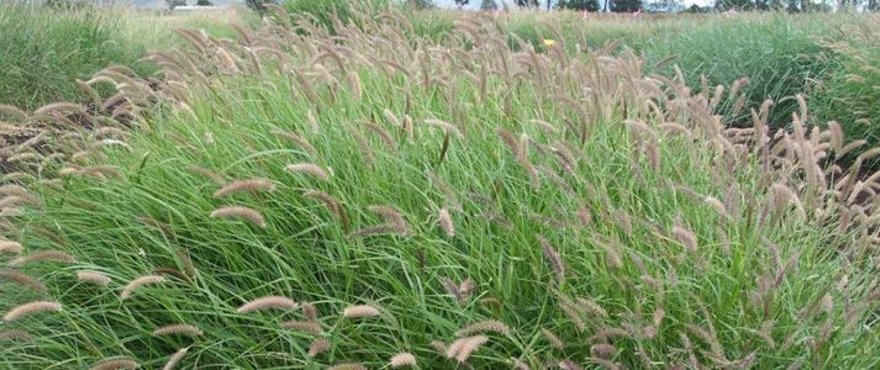Download a copy of the Gayndah Buffel Grass factsheet.
Gayndah Buffel grass is a native of low rainfall tropical to sub-tropical areas from Africa, India and Indonesia.
Gayndah is a medium height variety and is more prostrate but denser tillered. It grows to about one metre high with shorter and fewer underground rhizomes, but with a more dense root system than Biloela. It is less vigorous, but is often preferred by stock. The straw-coloured seeds are less densely packed.
Gayndah is intermediate between USA and Biloela in maturity and plant height and is suited to the light or medium texture soils.
Gayndah Buffel has much of the same climatic adaptation as Biloela and other tall cultivars but because of its lower height and greater leafiness it is favoured for sheep pastures.
It is a deep rooted summer growing perennial with drought resistance and tolerant to heavy grazing or burning.
Gayndah Buffel grass has the ability to respond quickly to any drought breaking rains. It will flower early but whilst flowering will continue to produce extra leaf and new shoots. The flower or seed head resembles the typical “fox tail”.
It is sown in areas receiving an annual rainfall of between 350 and 1000mm. Because of its ability to tolerate low rainfall it can be grown in areas not suitable to Rhodes grass or Green panic. It is less cold tolerant than Green Panic.
Mainly used as a permanent pasture, but can be used for hay or silage. Not suited to short-term pasture because too difficult to remove and binds nutrient.
Key features
- Finer, medium height buffel that establishes readily
- Adapted to a wide range of soil types, medium maturity
- Good stock tolerance
- Quick to respond after relatively small falls of rain
Establishment
Fresh seed often has high level of dormancy. Germination rate can be improved with storage of 6–18 months after harvest or by separating caryopses. Total live seed content is commonly 30–50%. Establishment is difficult on hard setting and heavy claysoils. Establishes readily if competition is controlled. Sown 0–1 cm deep at 1–2 kg seed/ha, the lower rate on sandyloam soils. Whilst it grows on a wide variety of soils it prefers the higher fertility scrub soils. It has been found that the addition of extra phosphorus aid in seeding vigour at establishment. The germination of seed improves with age and any seed sown whilst dormant will remain in the soil until the following growing season. The seed is “fluffy” therefore to overcome any difficulty at sowing use AgriCOTE Pro-Tech or it should be bulked up with other free flowing material Best sown through a roller drum, grass airseeder, modified fertiliser spreader or modified combine. Sow at and rely on follow-up rain for establishment.
Agronomy and management
Gayndah Buffel grass is slow to establish and grazing may need to be delayed anything up to 12 months, depending on establishment conditions. If possible, it is best to avoid grazing in the first year until after seed-set, which ensures plants are well-established, and gives lighter stands the opportunity to thicken up in subsequent years. Once established, Gayndah is very tolerant of regular cutting or grazing. Since quality declines rapidly with age, buffel grass pastures should be grazed sufficiently regularly and heavily to maintain in a leafy, more nutritious stage.
Performance
Yields depend greatly on soil fertility and growing conditions, but are mostly in the range of 2–9 t/ha DM, and under ideal conditions, up to 24 t/ha DM. Crude protein values are mostly in the range of 6–16%, and IVDMD and crude protein digestibility from 50–60%, depending on age of growth, cultivar, and soil fertility (incl. fertiliser use). P levels are usually higher than in other tropical grasses and range from 0.15–0.65% in the DM.
Animal production
Can carry up to 1 steer or 6 sheep/ha, depending on rainfall and soil fertility. Cattle can gain up to 180–200 kg/hd/yr at 2 ha/beast on fertile soils under good growing conditions. Generally less palatable than Panicum coloratum (Bambatsii panic) and P. maximum (Gatton/Green panic).
Toxicity
Oxalate levels can cause ‘big head’ (Osteodystrophia fibrosa) in horses, and oxalate poisoning in young or hungry sheep. However, with soluble oxalate levels of 1–2% in the DM, there is rarely a problem with mature ruminants.
Pest / disease resistance
The most serious disease is buffel grass blight caused by the fungus, Magnaporte grisea (anamorph Pyricularia grisea), a rampant leaf spot disease that reduces quality and production of forage and seed, and in some cases, destroys stands. Pyricularia grisea is a highly variable pathogen and differential responses have been found to occur, with some varieties of Cenchrus ciliaris being resistant to the various races of the pathogen. Other fungal species causing damage are Fusarium oxysporum, Bipolaris sp., and Claviceps sp. Alternative host for Claviceps fusiformis is pearl millet (Pennisetum glaucum). No significant pests or diseases. Recorded as being susceptible to maize streak monogeminivirus. A new species of cyst nematode, Heterodera goldeni, has been identified on Panicum coloratum in Egypt.
Suggested sowing rates
Recommended planting rates for AgriCOTE Pro-Tech for Gayndah Buffel are:
Marginal dryland: 4 – 6kg per hectare
Good dryland: 8 – 12kg per hectare
Irrigated: 12 – 15kg per hectare
Disclaimer: The information presented in this brochure is from official and other sources and is considered to be reliable. It is provided in good faith and every care has been taken to ensure its accuracy. Barenbrug does not accept any responsibility for the consequences that may arise from the acceptance of recommendations or the suggestions made.



